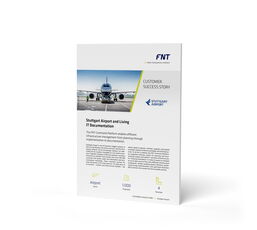
Stuttgart Airport and Living IT Documentation

Stuttgart Airport is one of Germany’s biggest airports. It links to long-distance rail and bus services, and the city’s subway network. All are increasingly making it an inter- modal hub for travelers. Alongside its core aviation business, Flughafen Stuttgart GmbH also operates numerous infrastructure facilities that provide more than 250 B2B customers with power, water, and information and communications technology. These customers account for some 40 percent of its total revenues.
For both parts of its business – aviation and infrastructure facilities – the airport needs to operate, maintain, upgrade, and expand a complex network of diverse and highly critical infrastructures. To do this, it deploys the FNT Command Platform, an integrated software system for planning and documenting complex and hybrid IT and telco infrastructures. As “living documentation,” it makes it easier to maintain an up-to-date record of the many different infrastructure components, thereby enabling greater efficiency, professional change implementation, and rapid fault resolution. B2B customers thus receive the best possible services.
Intermodal hub in southern Germany
More than 12 million passengers pass through Stuttgart Airport each year. The 400 hectare airport site is home to four terminals, 70 gates, some 6,000 square meters of retail space, and around 3,800 square meters of food outlets, plus two data centers. More than 55 airlines fly from here to over 140 destinations
In 2020, the year of the pandemic, the airport posted revenues of EUR 142 million, of which EUR 66.1 million was from aviation and EUR 75.9 million from other business activities
As a regional airport, Stuttgart Airport makes a crucial contribution to mobility in the state of Baden-Württemberg. More than 300 s business entities and public agencies operate on the airport campus. The operators have set themselves the goal of making Stuttgart Airport one of the best performing and most sustainable airports in Europe, in an initiative dubbed “fairport STR”.


Expansion Requires Professional Infrastructure Management
Looking at planned growth, it soon became clear that the airport’s existing IT infrastructure documentation – a mix of paper, CAD drawings, and Excel lists – was not a sustainable option for efficient centralized operations. The airport operator decided to look for a database solution that would simultaneously cover planning and documentation, allowing it to serve as a single source of truth. “Our aim was to implement an interdisciplinary infrastructure and service management tool, a ‘living managed database,’” recalls Matthias Kolb, Head of Information and Communication Services at Flughafen Stuttgart GmbH.
Alongside functions to aid faster fault rectification, the ide- al solution would also include cable and tray management and provide scalable support for other areas. The company chosen to provide advice and handle implementation was planning specialist and consultancy Geiger, which has core competencies in the fields of data center and network infrastructure, cable documentation, infrastructure management, and monitoring. The company has worked with Stuttgart Airport for more than 20 years.
After conducting proof-of-concept (PoC) tests with solutions from three providers, the decision was made to deploy the FNT Command Platform, which is already being successfully used by many German and international airports.
The key factor behind the choice of FNT Command as an integrated documentation solution was the platform’s broad functionality coupled with the flexibility to meet individual requirements over time.
Rigorous Approach to Implementation
From their extensive experience, Geiger knows that even the best documentation solution can only deliver maximum added value if it is properly implemented. In this case, that means seamless integration into existing business processes. Geiger relies on a proven six-stage implementation strategy to achieve this:
- Identify and prioritize requirements – What are the specific requirements of the company, the individual departments, and other stakeholders? What is the aim of the documentation? What needs to be documented and what must be implemented first?
- Standards and policies – Work together to specify user permissions, nomenclature, and general documentation rules.
- Proof of concept – Implement the documentation on the basis of the standards and policies in a discrete, pre- defined area. Conduct testing, make changes as necessary, and update the standards accordingly.
- Large-scale rollout – Apply best practices from the PoC across the entire site.
- Create acceptance – Provide training and information and introduce the documentation solution to all departments and stakeholders in order to maximize the benefits for all.
- Integration – Integrate the documentation into the organization’s IT and business processes to ensure living documentation.
Implementation of Documentation at Stuttgart Airport
In line with the above implementation strategy, the team headed by Matthias Kolb worked with Geiger to establish the requirements of all stakeholders and then to prioritize them, install the system, and define standards. The first step was to capture data on physical hardware, such as cables, patches, splices, and similar items. The defined standards were initially tested in the data center in the air traffic control building to obtain proof of concept. This was the fastest way to check whether the designations of cable panels, patch panels, and individual cables were consistent and, ultimately, whether all the requirements could be met. Rollout then took place in several stages over a period of three years. First, all fiber optic connections and fiber distribution technology, together with the tertiary user-agnostic communications network, were documented, including copper cables. That involved 4,429 fiber cables inside and outside buildings, two data centers, 94 secondary concentration points, 225 tertiary concentration points, and around 15,000 data connection units.

FNT Command Platform at Stuttgart Airport: How It’s Used Today
The steady addition of components saw cable management evolve into comprehensive infrastructure management. Between four and six airport employees are regular users of the system, with two of them using the solution almost constantly for planning purposes. Documentation via the FNT Command Platform is also the ideal solution for external service providers. The software is not just utilized as the basis for implementation planning on projects or as part of the order documentation process for smaller interventions, it is also important for quality assurance and acceptance checks.
Moreover, documentation from the FNT Command Platform is an integral part of the cable handbook made available by the airport to external service providers. This handbook makes it much easier for contractors to understand the requirements and prepare quotations. Training by FNT and instruction from Geiger ensured that all internal and external stakeholders were soon up to speed with the system. “FNT Command is simple and intuitive to use and was quickly accepted by our employees. Being comfortable with the system made deployment easier and facilitated the incorporation of documentation data into other IT and business processes,” explains Matthias Kolb.
Fault Rectification: When Every Minute Matters
Even a small outage can have a major impact at Stuttgart Airport, which supplies more than 250 shops and business with key infrastructure services, such as energy and WLAN. The aim is to ensure same-day fault rectification, or within 90 minutes in the case of some public agencies and businesses. FNT Command makes this process much easier. If there is a fault on the network, the solution flags the affected node. This helps to identify the impacted route and quickly narrow down the possible sources of the problem. Fault rectification is also much more efficient. Service technicians know precisely where the fault is located and have access to all the data on the device or cable in question. They can get down to work quickly and with the right tools. Switching to alternative routes is also very easy. “When a fault is identified, FNT Command suggests alternative signal paths. Switching takes just a few clicks. It used to involve several hours of work,” recalls Matthias Kolb. “Now it’s a matter of minutes.”

From Documentation to Planning: Closing the Circle
Another benefit for infrastructure operation arises if the data contained in the documentation is simultaneous ly used as the basis for change planning. To do this, the target status is defined in the documentation solution. When the changes have been implemented, inspected, and reviewed on site, the status is changed in the tool from planned to current. This integration into IT management processes allows data to be updated on the fly without any additional effort, ensuring that it remains aligned with reality on the ground. Or, as Mike Fischer puts it: “Before any change is made to the infrastructure, it has to be planned in advance in the system. That has the advantage of documenting changes ahead of time so the documentation always remains up to date.”
MLAT Project as an Example – Planned, Implemented, and Documented Using the FNT Command Platform
Integrated use of the FNT Command Platform as a planning and documentation tool is important for achieving acceptance across all departments, improving data quality, and for integration into other IT and business processes. Only then is it possible to create a kind of “living documentation” – and to add real value, as the following example shows. The German air traffic control service’s MLAT project was fully planned, implemented, approved, and documented using FNT Command. As the campus provider for the German air traffic control service, Flughafen Stuttgart GmbH is responsible for reliable signal tracing. There was significant time pressure: the existing multilateral radar system was no longer up to the job. To support the new MLAT system, more than 70 percent of the cabling had to be re-planned, moved, patched, and documented, totaling several installed kilometers. Two employees completed this project from planning through implementation to documentation in just nine weeks. “Without the support provided by FNT Command, we would have needed significantly more people to get the project over the line so quickly,” comments Matthias Kolb. “FNT Command has really boosted our efficiency.”
Looking to the Future: Extended Documentation Plans
Full documentation of Stuttgart Airport’s complex infrastructure is an ongoing task. The current focus is on capturing the telecommunications cables running between the buildings. Work is also being undertaken on the SAP-based configuration management database (CMDB), with the intention of hooking it up to FNT Command via a bidirectional interface. Extensive automation of IT management processes is another step. “FNT Command is an efficient planning tool that allows processes to be managed and automated across departments and service providers. It delivers significant time savings and greater transparency without losing data sovereignty. FNT and ‘living documentation’ have future-proofed the airport’s infrastructure management for the long term.”
Benefits of the FNT Command Platform

Stuttgart Airport is one of Germany’s biggest airports. It links to long-distance rail and bus services, and the city’s subway network. All are increasingly making it an inter- modal hub for travelers. Alongside its core aviation business, Flughafen Stuttgart GmbH also operates numerous infrastructure facilities that provide more than 250 B2B customers with power, water, and information and communications technology. These customers account for some 40 percent of its total revenues.
For both parts of its business – aviation and infrastructure facilities – the airport needs to operate, maintain, upgrade, and expand a complex network of diverse and highly critical infrastructures. To do this, it deploys the FNT Command Platform, an integrated software system for planning and documenting complex and hybrid IT and telco infrastructures. As “living documentation,” it makes it easier to maintain an up-to-date record of the many different infrastructure components, thereby enabling greater efficiency, professional change implementation, and rapid fault resolution. B2B customers thus receive the best possible services.
About FNT
Powerful, reliable and flexible infrastructures are the basis for all digital business processes and applications, especially those supporting Smart Cities, Industry 4.0 or 5G. With FNT’s integrated software solutions, organizations can record, document and manage complex and heterogeneous IT, telecommunications and data center infrastructures from the physical level all the way up the stack to business services. FNT stores this information in a manufacturer independent, uniform data model. In this way, FNT provides the necessary transparency and tools to plan and manage the IT, data center and telecommunications landscape more easily to eliminate faults faster, to manage transformations and changes more efficiently and to automate delivery of new digital services. Over 500 companies and public authorities worldwide rely on FNT, including more than half of the DAX30-listed corporations. FNT is headquartered in Ellwangen (Jagst) and has offices in the USA (Parsippany, New Jersey), UK (London), Singapore, Dubai and Russia (Moscow). FNT offers its software in numerous countries through partnerships with market-leading IT service providers and system integrators.
